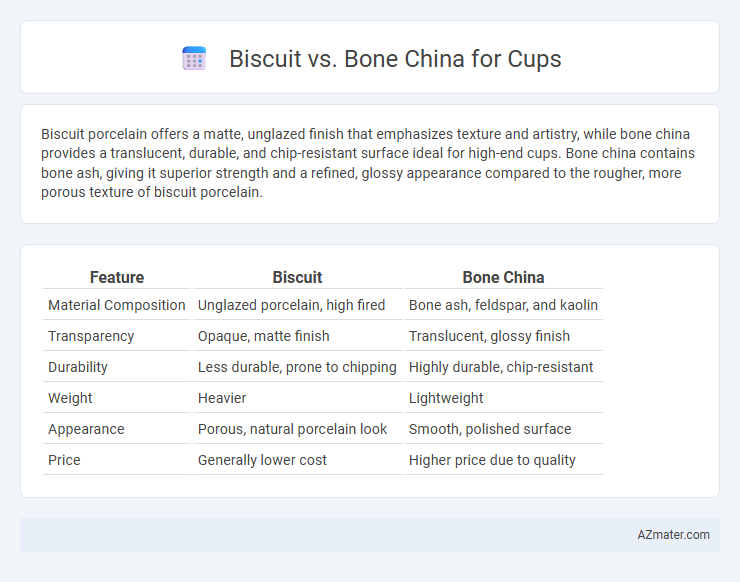Biscuit porcelain offers a matte, unglazed finish that emphasizes texture and artistry, while bone china provides a translucent, durable, and chip-resistant surface ideal for high-end cups. Bone china contains bone ash, giving it superior strength and a refined, glossy appearance compared to the rougher, more porous texture of biscuit porcelain.
Table of Comparison
| Feature | Biscuit | Bone China |
|---|---|---|
| Material Composition | Unglazed porcelain, high fired | Bone ash, feldspar, and kaolin |
| Transparency | Opaque, matte finish | Translucent, glossy finish |
| Durability | Less durable, prone to chipping | Highly durable, chip-resistant |
| Weight | Heavier | Lightweight |
| Appearance | Porous, natural porcelain look | Smooth, polished surface |
| Price | Generally lower cost | Higher price due to quality |
Introduction to Biscuit and Bone China
Biscuit porcelain, characterized by its unglazed, matte finish, offers a delicate, porous texture ideal for artistic cups with a soft, natural appearance. Bone china, composed of bone ash, feldspar, and kaolin, is renowned for its high strength, translucency, and smooth, glossy surface, making it a premium choice for durable and elegant cups. Both materials highlight distinct aesthetic and functional qualities, with biscuit focusing on raw, refined texture, and bone china emphasizing resilience and fine detail.
What is Biscuit Porcelain?
Biscuit porcelain, also known as bisque, is unglazed, matte-finished porcelain that showcases fine details and a smooth texture, differing from bone china which is glazed and translucent. Biscuit porcelain cups are valued for their natural, soft appearance and porous surface, ideal for display but less resistant to stains compared to bone china. Bone china contains bone ash, offering superior strength, translucency, and durability, making it preferred for functional cups, while biscuit porcelain emphasizes aesthetic appeal and craftsmanship.
What is Bone China?
Bone china is a type of porcelain known for its high levels of bone ash, which give it exceptional strength, whiteness, and translucency compared to other ceramics. It typically contains about 25-50% bone ash, combined with kaolin and feldspar, resulting in a delicate yet durable material ideal for fine cups and dinnerware. In contrast, biscuit porcelain is unglazed and matte, offering a different texture and aesthetic compared to the smooth, glossy finish of bone china cups.
Key Differences Between Biscuit and Bone China
Biscuit and bone china cups differ primarily in their composition and finish; biscuit porcelain is unglazed, offering a matte texture that highlights intricate details, whereas bone china includes bone ash, making it highly translucent, durable, and glossy. Bone china typically shows greater strength and chip resistance due to its unique blend of clay and bone ash, while biscuit porcelain is more fragile and often used for decorative collectibles. The aesthetic appeal of biscuit relies on its soft, chalky surface, contrasting with the smooth, polished appearance and refined translucency of bone china cups.
Appearance and Texture Comparison
Biscuit and bone china cups differ significantly in appearance and texture; biscuit porcelain features a matte, unglazed finish that provides a soft, chalky surface, while bone china boasts a smooth, glossy glaze with a translucent quality and a delicate, ivory-white color. Biscuit's porous texture offers a tactile, natural feel, contrasting with bone china's fine, dense composition that results in a lightweight, smooth, and cool-to-the-touch surface. These characteristics influence the aesthetic appeal and tactile experience, making biscuit cups rustic and understated, whereas bone china cups are elegant and refined.
Durability and Strength
Biscuit porcelain, known for its unglazed, matte finish, offers a delicate and porous texture that can chip or crack more easily under impact compared to bone china. Bone china incorporates bone ash, enhancing its strength and durability while maintaining a refined, translucent appearance, making it more resistant to chipping and suitable for daily use. The denser composition of bone china also provides superior resistance to thermal shock, increasing its lifespan in cups subjected to frequent temperature changes.
Porosity and Maintenance
Biscuit porcelain cups have higher porosity, making them more absorbent and prone to staining, which requires careful maintenance and gentle cleaning to preserve their matte finish. Bone china cups feature lower porosity, resulting in a denser, more non-absorbent surface that resists stains and moisture better, allowing easier cleaning and enhanced durability. Regular use of mild detergents and avoiding abrasive materials help maintain the integrity of both biscuit and bone china cups.
Popular Uses and Applications
Biscuit porcelain is favored for its matte finish and is commonly used in decorative figurines, ornamental cups, and collectible teacups where detailed artistry without glaze is desired. Bone china, renowned for its high strength and translucency, is predominantly chosen for luxury cup sets, fine dining crockery, and tea services that require durability combined with elegant appearance. Both materials find extensive applications in premium tableware, but biscuit porcelain emphasizes aesthetic display, while bone china prioritizes functional use and refined presentation.
Cost and Value Considerations
Biscuit porcelain cups generally cost less than bone china due to their simpler production process and lower material quality. Bone china cups offer higher durability, translucency, and a refined finish, resulting in greater long-term value despite the higher initial price. Consumers seeking affordability prioritize biscuit porcelain, while those valuing luxury and longevity prefer bone china for premium tea or coffee experiences.
Which is Better for Cups?
Biscuit porcelain offers a matte, unglazed finish that enhances the tactile experience and is highly resistant to chipping, making it ideal for everyday cup use. Bone china, composed of bone ash and fired at high temperatures, provides exceptional strength, translucency, and a glossy surface, offering an elegant and durable option for cups. For durability combined with refined aesthetics, bone china is generally considered better for cups, especially in formal settings.

Infographic: Biscuit vs Bone china for Cup
 azmater.com
azmater.com